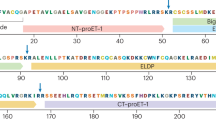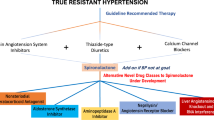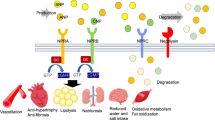Abstract
Rapid advances in the understanding of endothelin as a naturally occurring peptide with developmental and regulatory roles in normal physiology, along with a number of deleterious effects under pathologic conditions (including vasoconstriction, fibrosis, vascular hypertrophy, and inflammation) have led to the development of endothelin-receptor antagonists (ERAs). Bosentan, an antagonist with dual specificity for the endothelin-receptor subtypes A and B, has been shown to be efficacious and well tolerated in placebo-controlled clinical trials and is now approved in many countries, including the US, Canada, and Europe, for treatment of pulmonary arterial hypertension (PAH), including PAH associated with rheumatic diseases. ERAs with specificity for the endothelin-receptor subtype A, including sitaxsentan and ambrisentan, are currently undergoing investigation. This article reviews PAH associated with systemic rheumatic diseases and describes the role of ERAs in this setting.
Key Points
-
Pulmonary arterial hypertension (PAH) describes a group of diseases characterized by raised pulmonary arterial pressure and obstruction of small precapillary pulmonary arteries leading to right-heart failure
-
PAH can occur as a devastating complication in patients with systemic sclerosis
-
Various treatment approaches for PAH have been investigated, including endothelin-receptor antagonists
-
Data support the use of the oral dual endothelin-receptor antagonist bosentan in stabilizing or improving exercise capacity in patients with PAH associated with systemic sclerosis
-
More information on long-term therapy is needed in order to evaluate long-term outcome in this difficult-to-treat population
-
Oral bosentan at a dose of 125 mg twice daily is approved for treatment of PAH in many countries, including North America and Europe
-
Monthly monitoring of liver function tests is mandatory in bosentan-treated patients because of the possible elevation of hepatic aminotransferase levels
This is a preview of subscription content, access via your institution
Access options
Subscribe to this journal
Receive 12 print issues and online access
$209.00 per year
only $17.42 per issue
Buy this article
- Purchase on Springer Link
- Instant access to full article PDF
Prices may be subject to local taxes which are calculated during checkout


Similar content being viewed by others
References
Simonneau G et al. (2004) Clinical classification of pulmonary hypertension. J Am Coll Cardiol 43 (Suppl): 5S–12S
Galie N et al. (2004) Guidelines on diagnosis and treatment of pulmonary arterial hypertension. The Task Force on Diagnosis and Treatment of Pulmonary Arterial Hypertension of the European Society of Cardiology. Eur Heart J 25: 2243–2278
D'Alonzo GE et al. (1991) Survival in patients with primary pulmonary hypertension: results from a national prospective registry. Ann Int Med 115: 343–349
Kawut SM et al. (2003) Hemodynamics and survival in patients with pulmonary arterial hypertension related to systemic sclerosis. Chest 123: 344–350
Mukerjee D et al. (2003) Prevalence and outcome in systemic sclerosis associated pulmonary arterial hypertension: application of a registry approach. Ann Rheum Dis 62: 1088–1093
MacGregor AJ et al. (2001) Pulmonary hypertension in systemic sclerosis: risk factors for progression and consequences for survival. Rheumatology (Oxford) 40: 453–459
Koh E et al. (1996) Pulmonary hypertension in systemic sclerosis: an analysis of 17 patients. Rheumatology 35: 989–993
Rich S et al. (1992) The effect of high doses of calcium-channel blockers on survival in primary pulmonary hypertension. N Engl J Med 327: 76–81
Sitbon O et al. (2005) Long-term response to calcium-channel blockers in idiopathic pulmonary arterial hypertension. Circulation 111: 3105–3111
Badesch DB et al. (2000) Continuous intravenous epoprostenol for pulmonary hypertension due to the scleroderma spectrum of disease: a randomized, controlled trial. Ann Med Int 132: 425–434
Humbert M et al. (2004) Treatment of pulmonary arterial hypertension. N Engl J Med 351: 1425–1436
Ghofrani HA et al. (2004) Nitric oxide pathway and phosphodiesterase inhibitors in pulmonary arterial hypertension. J Am Coll Cardiol 43 (Suppl): 68S–72S
Channick RN et al. (2004) Endothelin receptor antagonists in pulmonary arterial hypertension. J Am Coll Cardiol 43 (Suppl): 62S–67S
Mayes MD (2003) Endothelin and endothelin receptor antagonists in systemic rheumatic disease. Arthritis Rheum 48: 1190–1199
Yanagisawa M et al. (1988) A novel potent vasoconstrictor peptide produced by vascular endothelial cells. Nature 332: 411–415
Zamora MR et al. (1990) Serum endothelin-1 concentrations and cold provocation in primary Raynaud's phenomenon. Lancet 336: 1144–1147
Julkunen H et al. (1991) Raised plasma concentrations of endothelin-1 in systemic lupus erythematosus. Ann Rheum Dis 50: 526–527
Giaid A et al. (1993) Expression of endothelin-1 in the lungs of patients with pulmonary hypertension. N Engl J Med 328: 1732–1739
Abraham DJ et al. (1997) Increased levels of endothelin-1 and differential endothelin type A and B receptor expression in scleroderma-associated fibrotic lung disease. Am J Pathol 151: 831–841
Schiffrin EL and Touyz RM (1998) Vascular biology of endothelin. J Cardiovasc Pharmacol 32 (Suppl 33): S2–S13
Sato K et al. (1995) Effects of separate and combined ETA and ETB blockade on ET-1-induced constriction in perfused rat lungs. Am J Physiol Lung Cell Mol Phys 269: 668–672
Clozel M and Gray GA (1995) Are there different ETB receptors mediating constriction and relaxation? J Cardiovasc Pharmacol 26 (Suppl 3): S262–S264
Rubens C et al. (2001) Big endothelin-1 and endothelin-1 plasma levels are correlated with the severity of primary pulmonary hypertension. Chest 120: 1562–1569
Montani D et al. (2005) Endothelin-1 and endothelin-3 plasma levels in severe idiopathic pulmonary arterial hypertension [abstract]. Eur J Clin Invest 35: I81
Galie N et al. (1996) Relation of endothelin-1 to survival in patients with primary pulmonary hypertension [abstract]. Eur J Clin Invest 26: A48
Yoshibayashi M et al. (1991) Plasma endothelin concentrations in patients with pulmonary hypertension associated with congenital heart defects. Evidence for increased production of endothelin in pulmonary circulation. Circulation 84: 2280–2285
Vincent JA et al. (1993) Relation of elevated plasma endothelin in congenital heart disease to increased pulmonary blood flow. Am J Cardiol 71: 1204–1207
Tutar HE et al. (1999) Plasma endothelin-1 levels in patients with left-to-right shunt with or without pulmonary hypertension. Int J Cardiol 70: 57–62
Uguccioni M et al. (1995) Endothelin-1 in idiopathic pulmonary fibrosis. J Clin Pathol 48: 330–334
Mohacsi A et al. (2004) Effects of endothelins on cardiac and vascular cells: new therapeutic target for the future? Curr Vasc Pharmacol 2: 53–63
Shi-Wen X et al. (2001) Fibroblast matrix gene expression and connective tissue remodeling: role of endothelin-1. J Invest Dermatol 116: 417–425
Kahaleh MB (2004) Vascular involvement in systemic sclerosis. Clin Exp Rheumatol 22 (Suppl 33): S19–S23
Seccia TM et al. (2003) Cardiac fibrosis occurs early and involves endothelin and AT-1 receptors in hypertension due to endogenous angiotensin II. J Am Coll Cardiol 41: 666–673
Clozel M and Salloukh H (2005) Role of endothelin in fibrosis and antifibrotic potential of bosentan. Ann Med 37: 2–12
Hocher B et al. (2000) Pulmonary fibrosis and chronic lung inflammation in ET-1 transgenic mice. Am J Respir Cell Mol Biol 23: 19–26
Channick RN et al. (2001) Effects of the dual endothelin-receptor antagonist bosentan in patients with pulmonary hypertension: a randomised placebo-controlled study. Lancet 358: 1119–1123
Rubin LJ et al. (2002) Bosentan therapy for pulmonary arterial hypertension. N Engl J Med 346: 896–903
Galie N et al. (2003) Effects of the oral endothelin-receptor antagonist bosentan on echocardiographic and doppler measures in patients with pulmonary arterial hypertension. J Am Coll Cardiol 41: 1380–1386
Sitbon O et al. (2003) Effects of the dual endothelin receptor antagonist bosentan in patients with pulmonary arterial hypertension: a 1-year follow-up study. Chest 124: 247–254
McLaughlin VV et al. (2005) Survival with first-line bosentan in patients with primary pulmonary hypertension. Eur Respir J 25: 244–249
Denton CP et al. (2005) Dual endothelin receptor antagonism in pulmonary arterial hypertension related to systemic sclerosis [abstract]. Eur J Clin Invest 35: I72
Barst RJ et al. (2002) Clinical efficacy of sitaxsentan, an endothelin-A receptor antagonist, in patients with pulmonary arterial hypertension: open-label pilot study. Chest 121: 1860–1868
Barst RJ et al. (2004) Sitaxsentan therapy for pulmonary arterial hypertension. Am J Respir Crit Care Med 169: 441–447
Langleben D et al. (2004) STRIDE 1: effects of the selective ETA receptor antagonist, sitaxsentan sodium, in a patient population with pulmonary arterial hypertension that meets traditional inclusion criteria of previous pulmonary arterial hypertension trials. J Cardiovasc Pharmacol 44 (Suppl 1): S80–S84
Galie N et al. (2005) Ambrisentan long-term safety and efficacy in pulmonary arterial hypertension—one year follow-up [Abstract]. Proc Am Thorac Soc 2: A298
Langleben D et al. (2004) Sustained symptomatic, functional, and hemodynamic benefit with the selective endothelin-A receptor antagonist, sitaxsentan, in patients with pulmonary arterial hypertension: a 1-year follow-up study. Chest 126: 1377–1381
Billman GE (2002) Ambrisentan (Myogen). Curr Opin Investig Drugs 3: 1483–1486
Frost A et al. (2005) Ambrisentan improves 6-minute walk distance comparably for WHO class II and III PAH patients [abstract]. American Thoracic Society, San Diego
Galie N et al. (2005) Ambrisentan therapy for pulmonary arterial hypertension. J Am Coll Cardiol 46: 529–535
Humbert M et al. (2005) Long-term safety profile of bosentan in daily practice [abstract]. Eur J Clin Invest 35: I73
Denton C et al. (2005) Long-term safety profile of bosentan in patients with systemic sclerosis and pulmonary arterial hypertension: results from the TRAX database [abstract]. Ann Rheum Dis 64 (Suppl III): 294
Humbert M et al. (2004) Cellular and molecular pathobiology of pulmonary arterial hypertension. J Am Coll Cardiol 43 (Suppl): 13S–24S
Galie N et al. (2004) Comparative analysis and evidence-based treatment algorithm in pulmonary arterial hypertension. J Am Coll Cardiol 43 (Suppl): 81S–88S
Badesch DB et al. (2004) Medical therapy for pulmonary arterial hypertension: ACCP evidence-based clinical practice guidelines. Chest 126 (Suppl): 35S–62S
Clapp LH et al. (2002) Differential effects of stable prostacyclin analogs on smooth muscle proliferation and cyclic AMP generation in human pulmonary artery. Am J Respir Cell Mol Biol 26: 194–120
Moncada S et al. (1976) An enzyme isolated from arteries transforms prostaglandin endoperoxides to an unstable substance that inhibits platelet aggregation. Nature 263: 663–665
Rubin LJ et al. (1990) Treatment of primary pulmonary hypertension with continuous intravenous prostacyclin (epoprostenol). Results of a randomized trial. Ann Intern Med 112: 485–491
Wilkens H et al. (2001) Effect of inhaled iloprost plus oral sildenafil in patients with primary pulmonary hypertension. Circulation 104: 1218–1222
Author information
Authors and Affiliations
Corresponding author
Ethics declarations
Competing interests
The authors have relationships with drug companies including Actelion, Encysive, GlaxoSmithKline, Myogen, Schering, Pfizer and United Therapeutics. In addition to being investigators in trials involving these companies, relationships include consultancy services and memberships of scientific advisory boards.
Rights and permissions
About this article
Cite this article
Humbert, M., Simonneau, G. Drug Insight: endothelin-receptor antagonists for pulmonary arterial hypertension in systemic rheumatic diseases. Nat Rev Rheumatol 1, 93–101 (2005). https://doi.org/10.1038/ncprheum0048
Received:
Accepted:
Issue Date:
DOI: https://doi.org/10.1038/ncprheum0048
This article is cited by
-
Pulmonary hypertension in systemic lupus erythematosus: a systematic review and analysis of 642 cases in Chinese population
Rheumatology International (2013)
-
Genetics of systemic sclerosis-associated pulmonary arterial hypertension: Recent progress and current concepts
Current Rheumatology Reports (2009)



